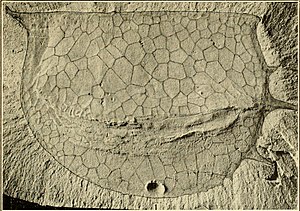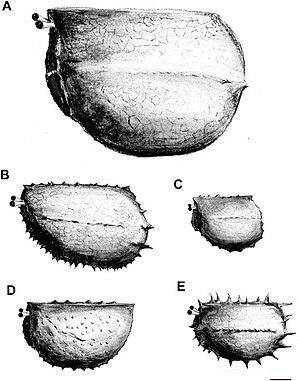Tuzoia
| Tuzoia Temporal range:
| |
|---|---|

| |
| Carapace of Tuzoia retifera | |
| Scientific classification | |
| Kingdom: | |
| Phylum: | |
| Order: | |
| Family: | |
| Genus: | Tuzoia Walcott, 1912
|
| Type species | |
| Tuzoia retifera Walcott, 1912
| |
Tuzoia (from Mount Tuzo, a mountain in the Canadian Rockies) is an extinct genus of large bivalved arthropod known from Early to Middle Cambrian marine environments from what is now North America, Australia, China, Europe and Siberia. The large, domed carapace reached lengths of 180 millimetres (7.1 in), making them amongst the largest known Cambrian arthropods.
Along the sides of the carapace a spiked ridge is present, and the edges of the carapace are also spiked in many species. These spines likely functioned to aid stability while swimming. The carapaces are marked with a reticulate (net-like) pattern, which was likely to increase the structural integrity of the valves while remaining lightweight.[1][2] They possessed a single pair of large spherical stalked eyes, as well as simple segmented anntennae.[1] There appears to have been a robust pair of segmented frontal appendages close to the head,[3] as well as other pairs of appendages along the trunk.[4] The lifestyle of Tuzoia is thought to have been that of a pelagic freely swimming organism.[1]
They were formerly considered to be the only members of the family Tuzoiidae until 2022, when a new genus Duplapex was described from the Cambrian of China, which differs from Tuzoia by having a flat carapace. The exact position of Tuzoia relative to other arthropods is uncertain due to most of their soft tissues being poorly known, though a close relationship between tuzoiids and the bivalved arthropod Isoxys has been proposed based on similarities of their carapaces.[5]
Species
After Vannier et al. 2007. and subsequent literature.[1][6]
- Tuzoia retifera Walcott, 1912 (type) Burgess Shale, Canada, Utah, USA
- Tuzoia burgessensis Resser, 1929, Burgess Shale, Canada
- Tuzoia guntheri Robison & Richards, 1981 Marjum Formation Utah, USA
- Tuzoia bispinosa Yuan and Zhao, 1999 Kaili Formation, Guizhou, China
- Tuzoia polleni Resser, 1929 Eager Formation, Canada, Parker Shale, Vermont, Pioche Shale, Nevada Kinzers Formation, Pennsylvania, USA
- Tuzoia australis Glaessner, 1979 Emu Bay Shale, Australia
- Tuzoia manchuriensis Resser and Endo, 1937 Tangshih Formation Liaoning, China (poorly known)
- Tuzoia sinensis P'an, 1957 Wulongqing Formation Yunnan, China (poorly known)
- Tuzoia tylodesa Luo et Hu et al., 2006 Wulongqing Formation Yunnan, China
- Tuzoia multispinosa Zhao, 2015 Wulongqing Formation Yunnan, China[7][6]
- Tuzoia lazizhaiensis Wen et al., 2019 Balang Formation, Hunan, China.[4]
- Tuzoia jianheensis Chen and Zhao, 2017 Tsinghsutung Formation, Guzihou, China[8]
Indeterminate remains are also known from the Jince Formation of the Czech Republic.[1] As well as the Sinsk Lagerstatte of Siberia.[9][6]
References
- ^ a b c d e Vannier, J.; Caron, J.-B.; Yuan, J.-L.; Briggs, D. E. G.; Collins, D.; Zhao, Y.-L.; Zhu, M.-Y. (2007). "Tuzoia: morphology and lifestyle of a large bivalved arthropod of the Cambrian seas". Journal of Paleontology. 81 (3): 445–471. doi:10.1666/pleo05070.1. S2CID 197540482.
- ^ Julien Kimmig & Brian R. Pratt (2015). "Soft-bodied biota from the middle Cambrian (Drumian) Rockslide Formation, Mackenzie Mountains, northwestern Canada". Journal of Paleontology. 89 (1): 51–71. doi:10.1017/jpa.2014.5. S2CID 130268424.
- ^ Caron, Jean-Bernard; Gaines, Robert R.; Mángano, M. Gabriela; Streng, Michael; Daley, Allison C. (September 2010). "A new Burgess Shale–type assemblage from the "thin" Stephen Formation of the southern Canadian Rockies". Geology. 38 (9): 811–814. Bibcode:2010Geo....38..811C. doi:10.1130/G31080.1. ISSN 1943-2682.
- ^ a b Wen, Rongqin; Babcock, Loren E.; Peng, Jin; Liu, Shuai; Liang, Boyan (November 2019). Sigwart, Julia (ed.). "The bivalved arthropod Tuzoia from the Balang Formation (Cambrian Stage 4) of Guizhou, China, and new observations on comparative species". Papers in Palaeontology. 5 (4): 719–742. doi:10.1002/spp2.1262. ISSN 2056-2802. S2CID 199636059.
- ^ Ma, Jiaxin; Lin, Weiliang; Liu, Cong; Sun, Ao; Wu, Yu; Wu, Yuheng; Fu, Dongjing (January 2022). "A new bivalved arthropod from the Cambrian (Stage 3) Qingjiang biota expands the palaeogeographical distribution and increases the diversity of Tuzoiidae". Journal of the Geological Society. 179 (1): jgs2020–229. Bibcode:2022JGSoc.179..229M. doi:10.1144/jgs2020-229. ISSN 0016-7649. S2CID 236289449.
- ^ a b c Yichen, Wu; Jianni, Liu (2022). "New Data on the Bivalved Arthropod Tuzoia From the Cambrian (Series 2, Stage 4) Guanshan Biota in Kunming, Yunnan, Southwest China". Frontiers in Earth Science. 10: 862679. Bibcode:2022FrEaS..10.2679W. doi:10.3389/feart.2022.862679. ISSN 2296-6463.
- ^ Zhao, J. (2015).The Revision of Tuzoia and Longquania from Early Cambrian Guanshan Biota of Eastern Yunnan, China. Published Master Degree thesis. China: Northwest University, 56. [in Chinese with English abstract].
- ^ Chen, W. Y., Zhao, Y. L., Yang, X. L., and Wen, R. Q. (2017). Tuzoia Walcott, 1912 from the Cambrian ‘Tsinghsutung Formation’ of Guzihou, China. Acta Palaeontologica Sinica 56, 301–311. [in Chinese with English abstract].
- ^ Ivantsov, A. I., Zhuravlev, A. I., Krasilov, V. A., Leguta, A. V., Melnikova, L. M., Urbanek, A., et al. (2005). Unique Sinsk Localities of Early Cambrian Organisms (Siberia Platform). Moscow: Nauka. Rossiyskaya Akademia Nauk, 143. [in Russian].
External links
- "Tuzoia burgessensis". Burgess Shale Fossil Gallery. Virtual Museum of Canada. 2011.Error: "Q148514" is not a valid Wikidata entity ID.
- Articles with short description
- Short description with empty Wikidata description
- Articles with 'species' microformats
- Taxonbars desynced from Wikidata
- Taxonbar pages requiring a Wikidata item
- Taxonbars with invalid from parameters
- Taxonbars without secondary Wikidata taxon IDs
- Burgess Shale fossils
- Wheeler Shale
- Cambrian genus extinctions

